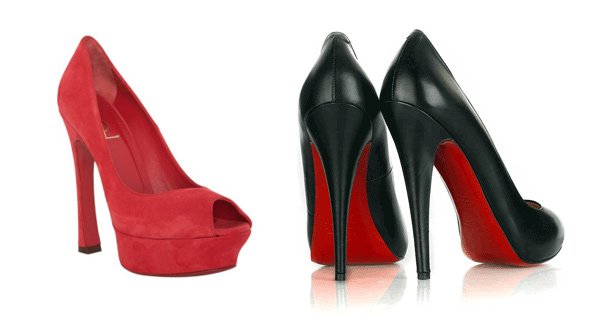The article is written by John Mathers, CEO of Holmes & Marchant Group
Louboutin v YSL; Cadbury v Nestle; and Reckitt Benckiser v Boots’ own label. It’s usual for these brands to lock horns on the shop floor, less so in the court room.
Yet that’s exactly what’s been happening over recent months, with shoe maker Louboutin currently fighting its corner against Yves Saint Laurent to own the colour red on the soles of its shoes; Cadbury winning a small victory against rival Nestle in its long-running legal fracas over the use of its distinctive purple colour; and Reckitt Benckiser being forced to bow to Boots in a ruling over the use of the word ‘ultra’ on its skincare packaging.
Photo: Louboutin vs Yves Saint Laurent in a red-sole shoe lawsuit, from www.speak-fashion.de
For those of us with an interest in branding, the moot point lies less with who wins or loses in the courtroom, and much more do with the rising equity brands across all categories are attaching to words and colours.
It’s nothing new that brands rely on colour recognition, and in some cases words, to boost consumer recognition on noisy shelves. Both are vital in driving market share; and with the growing number of brands entering the market, not to mention retailers’ own-brands positioning themselves as serious contenders, the fight for share is intensifying.
But while there’s no question that colours and words have an obvious value, surely now’s the time to move beyond such reliance on these stalwarts and invest in elements that make brands more intrinsically distinctive? That is to say, better naming protocols, structural differentiation, innovative new lines and extensions, as well as well-designed visuals.
Design as a pre-emptive defence mechanism cannot be underestimated: it can add real value to a product. Take Kraft’s Philadelphia brand as a case in point; the overall structure of the pack was overhauled in favour of a new oval design sporting a plastic, sealable lid that replaced the old foil lid, while bold new graphics cement the strength of the refreshed brand.
Own brand has struggled to catch up and mimic the design. And even if it does, Philadelphia has already built its brand equity, had an amazing head start, and continued to innovate with many new flavours. There is genuine value and a design differential in the total package now.
Building in ‘defensible design’ to your product lines means when an alternative pops up—regardless of whether it’s a brand competitor or an own-brand challenger — there will be enough equity and inherent value to make it a more worthy choice.
So while you can’t blame Louboutin and Cadbury for claiming a colour—and even Reckitt for laying claim to something as generic as the word ‘ultra’—there’s a lot to be said for doing more to continually innovate and build more robust, defensible brand and design equities.
About the Author
John Mathers currently holds position of CEO of Holmes & Marchant Group. He was previously CEO at Enterprise IG (now The Brand Union) and has held similar posts at Fitch and Blue Marlin. He is also a former president of the Design Business Association, and is currently on the advisory board of DOTT Cornwall.

